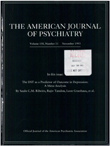Biological correlates of mental activity studied with PET
Abstract
The development of newer imaging techniques that allow direct investigation of the function of the human brain under normal and pathological conditions has affected the way in which we conceive of the mind/brain relation. In this report the authors use examples from findings obtained with positron emission tomography (PET) to illustrate the highly interactive organization of the brain. Because operations in the brain require the participation of various brain areas, a model that does not require a one-to-one relationship between the physical and mental, but rather allows an association between clusters of physical processes and one or more mental phenomena, may reflect better the relation between physical brain phenomena and mental activities.
Access content
To read the fulltext, please use one of the options below to sign in or purchase access.- Personal login
- Institutional Login
- Sign in via OpenAthens
- Register for access
-
Please login/register if you wish to pair your device and check access availability.
Not a subscriber?
PsychiatryOnline subscription options offer access to the DSM-5 library, books, journals, CME, and patient resources. This all-in-one virtual library provides psychiatrists and mental health professionals with key resources for diagnosis, treatment, research, and professional development.
Need more help? PsychiatryOnline Customer Service may be reached by emailing [email protected] or by calling 800-368-5777 (in the U.S.) or 703-907-7322 (outside the U.S.).



